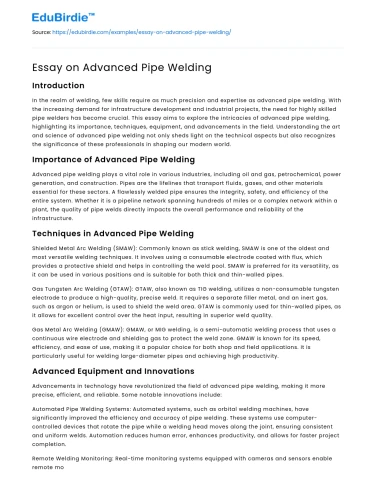Introduction
In the realm of welding, few skills require as much precision and expertise as advanced pipe welding. With the increasing demand for infrastructure development and industrial projects, the need for highly skilled pipe welders has become crucial. This essay aims to explore the intricacies of advanced pipe welding, highlighting its importance, techniques, equipment, and advancements in the field. Understanding the art and science of advanced pipe welding not only sheds light on the technical aspects but also recognizes the significance of these professionals in shaping our modern world.
Importance of Advanced Pipe Welding
Advanced pipe welding plays a vital role in various industries, including oil and gas, petrochemical, power generation, and construction. Pipes are the lifelines that transport fluids, gases, and other materials essential for these sectors. A flawlessly welded pipe ensures the integrity, safety, and efficiency of the entire system. Whether it is a pipeline network spanning hundreds of miles or a complex network within a plant, the quality of pipe welds directly impacts the overall performance and reliability of the infrastructure.
Save your time!
We can take care of your essay
- Proper editing and formatting
- Free revision, title page, and bibliography
- Flexible prices and money-back guarantee
Techniques in Advanced Pipe Welding
Shielded Metal Arc Welding (SMAW): Commonly known as stick welding, SMAW is one of the oldest and most versatile welding techniques. It involves using a consumable electrode coated with flux, which provides a protective shield and helps in controlling the weld pool. SMAW is preferred for its versatility, as it can be used in various positions and is suitable for both thick and thin-walled pipes.
Gas Tungsten Arc Welding (GTAW): GTAW, also known as TIG welding, utilizes a non-consumable tungsten electrode to produce a high-quality, precise weld. It requires a separate filler metal, and an inert gas, such as argon or helium, is used to shield the weld area. GTAW is commonly used for thin-walled pipes, as it allows for excellent control over the heat input, resulting in superior weld quality.
Gas Metal Arc Welding (GMAW): GMAW, or MIG welding, is a semi-automatic welding process that uses a continuous wire electrode and shielding gas to protect the weld zone. GMAW is known for its speed, efficiency, and ease of use, making it a popular choice for both shop and field applications. It is particularly useful for welding large-diameter pipes and achieving high productivity.
Advanced Equipment and Innovations
Advancements in technology have revolutionized the field of advanced pipe welding, making it more precise, efficient, and reliable. Some notable innovations include:
Automated Pipe Welding Systems: Automated systems, such as orbital welding machines, have significantly improved the efficiency and accuracy of pipe welding. These systems use computer-controlled devices that rotate the pipe while a welding head moves along the joint, ensuring consistent and uniform welds. Automation reduces human error, enhances productivity, and allows for faster project completion.
Remote Welding Monitoring: Real-time monitoring systems equipped with cameras and sensors enable remote monitoring of welding parameters and the quality of the welds. This technology allows experts to oversee and provide guidance for complex welding operations, ensuring adherence to strict quality standards. Remote monitoring also enables prompt identification and rectification of any issues that may arise during the welding process.
Laser Welding: Laser welding has gained popularity in advanced pipe welding due to its high precision and ability to produce narrow, deep welds with minimal heat-affected zones. Laser welding offers superior control over the welding process and can be used with a wide range of materials, including stainless steel and exotic alloys. It is particularly beneficial for applications that require high-quality, defect-free welds.
Non-Destructive Testing (NDT): NDT techniques, such as radiographic testing, ultrasonic testing, and magnetic particle inspection, play a crucial role in ensuring the integrity of pipe welds. These methods allow for the detection of any defects or flaws in the welds without causing damage to the pipe. NDT is essential in meeting industry standards and regulations, guaranteeing the safety and reliability of the welded pipes.
Conclusion
Advanced pipe welding is a specialized skill that requires a combination of technical knowledge, expertise, and precision. The importance of skilled pipe welders cannot be understated, as they contribute to the construction of critical infrastructure and ensure the safe and efficient transport of fluids and gases. With evolving techniques, advanced equipment, and innovative solutions, the field of advanced pipe welding continues to progress, enhancing the quality, reliability, and longevity of welded pipes. As we rely on these professionals for our industrial needs, it is essential to recognize their contributions and support their continuous development in this critical field.






 Stuck on your essay?
Stuck on your essay?

